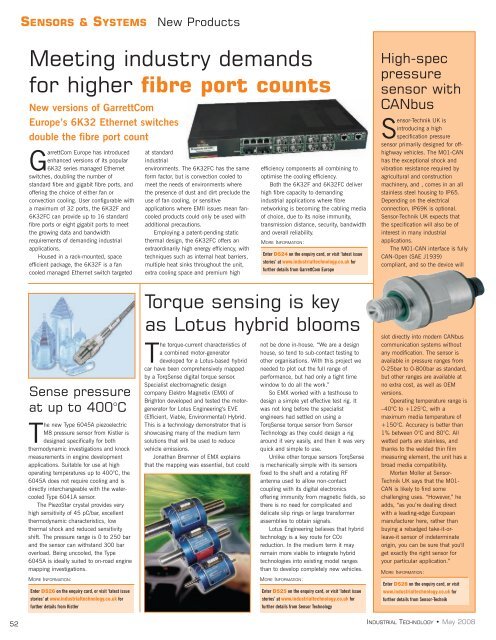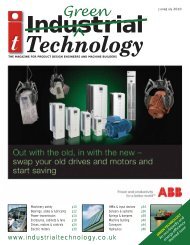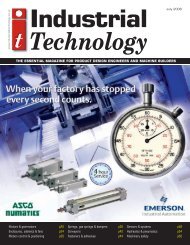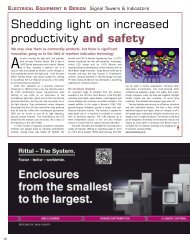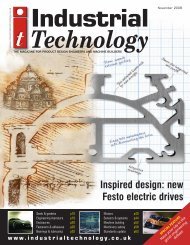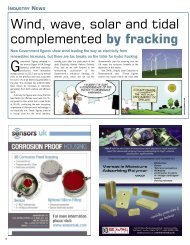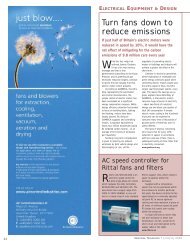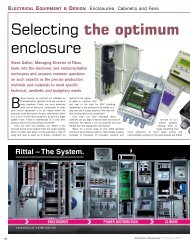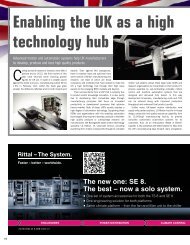sensors & systems - Industrial Technology Magazine
sensors & systems - Industrial Technology Magazine
sensors & systems - Industrial Technology Magazine
Create successful ePaper yourself
Turn your PDF publications into a flip-book with our unique Google optimized e-Paper software.
SENSORS & SYSTEMS<br />
New Products<br />
Meeting industry demands<br />
for higher fibre port counts<br />
New versions of GarrettCom<br />
Europe’s 6K32 Ethernet switches<br />
double the fibre port count<br />
GarrettCom Europe has introduced<br />
enhanced versions of its popular<br />
6K32 series managed Ethernet<br />
switches, doubling the number of<br />
standard fibre and gigabit fibre ports, and<br />
offering the choice of either fan or<br />
convection cooling. User configurable with<br />
a maximum of 32 ports, the 6K32F and<br />
6K32FC can provide up to 16 standard<br />
fibre ports or eight gigabit ports to meet<br />
the growing data and bandwidth<br />
requirements of demanding industrial<br />
applications.<br />
Housed in a rack-mounted, space<br />
efficient package, the 6K32F is a fan<br />
cooled managed Ethernet switch targeted<br />
at standard<br />
industrial<br />
environments. The 6K32FC has the same<br />
form factor, but is convection cooled to<br />
meet the needs of environments where<br />
the presence of dust and dirt preclude the<br />
use of fan cooling, or sensitive<br />
applications where EMIl issues mean fancooled<br />
products could only be used with<br />
additional precautions.<br />
Employing a patent-pending static<br />
thermal design, the 6K32FC offers an<br />
extraordinarily high energy efficiency, with<br />
techniques such as internal heat barriers,<br />
multiple heat sinks throughout the unit,<br />
extra cooling space and premium high<br />
efficiency components all combining to<br />
optimise the cooling efficiency.<br />
Both the 6K32F and 6K32FC deliver<br />
high fibre capacity to demanding<br />
industrial applications where fibre<br />
networking is becoming the cabling media<br />
of choice, due to its noise immunity,<br />
transmission distance, security, bandwidth<br />
and overall reliability.<br />
MORE INFORMATION:<br />
Enter D524 on the enquiry card, or visit ‘latest issue<br />
stories’ at www.industrialtechnology.co.uk for<br />
further details from GarrettCom Europe<br />
High-spec<br />
pressure<br />
sensor with<br />
CANbus<br />
Sensor-Technik UK is<br />
introducing a high<br />
specification pressure<br />
sensor primarily designed for offhighway<br />
vehicles. The M01-CAN<br />
has the exceptional shock and<br />
vibration resistance required by<br />
agricultural and construction<br />
machinery, and , comes in an all<br />
stainless steel housing to IP65.<br />
Depending on the electrical<br />
connection, IP69K is optional.<br />
Sensor-Technik UK expects that<br />
the specification will also be of<br />
interest in many industrial<br />
applications.<br />
The M01-CAN interface is fully<br />
CAN-Open (SAE J1939)<br />
compliant, and so the device will<br />
Sense pressure<br />
at up to 400°C<br />
The new Type 6045A piezoelectric<br />
M8 pressure sensor from Kistler is<br />
designed specifically for both<br />
thermodynamic investigations and knock<br />
measurements in engine development<br />
applications. Suitable for use at high<br />
operating temperatures up to 400°C, the<br />
6045A does not require cooling and is<br />
directly interchangeable with the watercooled<br />
Type 6041A sensor.<br />
The PiezoStar crystal provides very<br />
high sensitivity of 45 pC/bar, excellent<br />
thermodynamic characteristics, low<br />
thermal shock and reduced sensitivity<br />
shift. The pressure range is 0 to 250 bar<br />
and the sensor can withstand 300 bar<br />
overload. Being uncooled, the Type<br />
6045A is ideally suited to on-road engine<br />
mapping investigations.<br />
MORE INFORMATION:<br />
Enter D526 on the enquiry card, or visit ‘latest issue<br />
stories’ at www.industrialtechnology.co.uk for<br />
further details from Kistler<br />
Torque sensing is key<br />
as Lotus hybrid blooms<br />
The torque-current characteristics of<br />
a combined motor-generator<br />
developed for a Lotus-based hybrid<br />
car have been comprehensively mapped<br />
by a TorqSense digital torque sensor.<br />
Specialist electromagnetic design<br />
company Elektro Magnetix (EMX) of<br />
Brighton developed and tested the motorgenerator<br />
for Lotus Engineering’s EVE<br />
(Efficient, Viable, Environmental) Hybrid.<br />
This is a technology demonstrator that is<br />
showcasing many of the medium term<br />
solutions that will be used to reduce<br />
vehicle emissions.<br />
Jonathan Bremner of EMX explains<br />
that the mapping was essential, but could<br />
not be done in-house. “We are a design<br />
house, so tend to sub-contact testing to<br />
other organisations. With this project we<br />
needed to plot out the full range of<br />
performance, but had only a tight time<br />
window to do all the work.”<br />
So EMX worked with a testhouse to<br />
design a simple yet effective test rig. It<br />
was not long before the specialist<br />
engineers had settled on using a<br />
TorqSense torque sensor from Sensor<br />
<strong>Technology</strong> as they could design a rig<br />
around it very easily, and then it was very<br />
quick and simple to use.<br />
Unlike other torque <strong>sensors</strong> TorqSense<br />
is mechanically simple with its <strong>sensors</strong><br />
fixed to the shaft and a rotating RF<br />
antenna used to allow non-contact<br />
coupling with its digital electronics<br />
offering immunity from magnetic fields, so<br />
there is no need for complicated and<br />
delicate slip rings or large transformer<br />
assemblies to obtain signals.<br />
Lotus Engineering believes that hybrid<br />
technology is a key route for CO2<br />
reduction. In the medium term it may<br />
remain more viable to integrate hybrid<br />
technologies into existing model ranges<br />
than to develop completely new vehicles.<br />
MORE INFORMATION:<br />
Enter D525 on the enquiry card, or visit ‘latest issue<br />
stories’ at www.industrialtechnology.co.uk for<br />
further details from Sensor <strong>Technology</strong><br />
slot directly into modern CANbus<br />
communication <strong>systems</strong> without<br />
any modification. The sensor is<br />
available in pressure ranges from<br />
0-25bar to 0-800bar as standard,<br />
but other ranges are available at<br />
no extra cost, as well as OEM<br />
versions.<br />
Operating temperature range is<br />
–40°C to +125°C, with a<br />
maximum media temperature of<br />
+150°C. Accuracy is better than<br />
1% between 0°C and 80°C. All<br />
wetted parts are stainless, and<br />
thanks to the welded thin film<br />
measuring element, the unit has a<br />
broad media compatibility.<br />
Morten Moller at Sensor-<br />
Technik UK says that the M01-<br />
CAN is likely to find some<br />
challenging uses. “However,” he<br />
adds, “as you’re dealing direct<br />
with a leading-edge European<br />
manufacturer here, rather than<br />
buying a rebadged take-it-orleave-it<br />
sensor of indeterminate<br />
origin, you can be sure that you'll<br />
get exactly the right sensor for<br />
your particular application.”<br />
MORE INFORMATION:<br />
Enter D528 on the enquiry card, or visit<br />
www.industrialtechnology.co.uk for<br />
further details from Sensor-Technik<br />
52<br />
INDUSTRIAL TECHNOLOGY • May 2008


